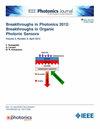利用二次谐波发生效应实现耗散孤子共振脉冲的非线性频率转换
IF 2.1
4区 工程技术
Q3 ENGINEERING, ELECTRICAL & ELECTRONIC
引用次数: 0
摘要
我们首次展示了如何利用二次谐波产生效应来上转换耗散孤子共振激光脉冲。我们设计并制造了两台独立的耗散孤子共振激光器,分别在 1.06 μm 和 1.56 μm 波长范围内发射矩形纳秒脉冲。具有适当周期的周期性极化铌酸锂晶体被用作非线性介质。由于二次谐波发生效应,产生了中心波长为 532 纳米和 780 纳米、脉冲能量分别为 0.15 μJ 和 0.02 μJ 的耗散孤子共振脉冲。1.06 μm 和 1.56 μm 脉冲的转换效率分别为 30% 和 4%。本文章由计算机程序翻译,如有差异,请以英文原文为准。
Nonlinear Frequency Conversion of Dissipative Soliton Resonance Pulses Using the Second Harmonic Generation Effect
We present the first demonstration of using the second harmonic generation effect to upconvert dissipative soliton resonance laser pulses. We have designed and built two independent dissipative soliton resonance lasers, emitting rectangular shaped, nanosecond pulses in the 1.06 μm and 1.56 μm wavelength regime, respectively. Periodically poled lithium niobate crystals with appropriate periods were used as the nonlinear medium. Dissipative soliton resonance pulses with central wavelengths of 532 nm and 780 nm and pulse energies of 0.15 μJ and 0.02 μJ were generated as the result of the second harmonic generation effects. Conversion efficiencies of 30% and 4% were obtained for conversion of 1.06 μm and 1.56 μm pulses, respectively.
求助全文
通过发布文献求助,成功后即可免费获取论文全文。
去求助
来源期刊

IEEE Photonics Journal
ENGINEERING, ELECTRICAL & ELECTRONIC-OPTICS
CiteScore
4.50
自引率
8.30%
发文量
489
审稿时长
1.4 months
期刊介绍:
Breakthroughs in the generation of light and in its control and utilization have given rise to the field of Photonics, a rapidly expanding area of science and technology with major technological and economic impact. Photonics integrates quantum electronics and optics to accelerate progress in the generation of novel photon sources and in their utilization in emerging applications at the micro and nano scales spanning from the far-infrared/THz to the x-ray region of the electromagnetic spectrum. IEEE Photonics Journal is an online-only journal dedicated to the rapid disclosure of top-quality peer-reviewed research at the forefront of all areas of photonics. Contributions addressing issues ranging from fundamental understanding to emerging technologies and applications are within the scope of the Journal. The Journal includes topics in: Photon sources from far infrared to X-rays, Photonics materials and engineered photonic structures, Integrated optics and optoelectronic, Ultrafast, attosecond, high field and short wavelength photonics, Biophotonics, including DNA photonics, Nanophotonics, Magnetophotonics, Fundamentals of light propagation and interaction; nonlinear effects, Optical data storage, Fiber optics and optical communications devices, systems, and technologies, Micro Opto Electro Mechanical Systems (MOEMS), Microwave photonics, Optical Sensors.
 求助内容:
求助内容: 应助结果提醒方式:
应助结果提醒方式:


